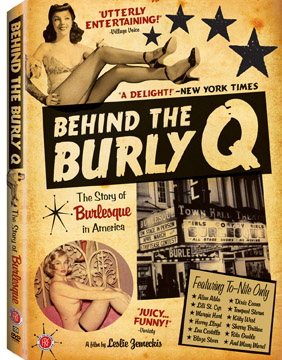With noms de plume like Tempest Storm, Mademoiselle Fifi and Blaze Starr, the prodigious women of burlesque’s golden age forged an industry unlike any other in 20th century America. Their innovation, creativity and grit are captured in “Behind the Burly Q,” a documentary from writer/director/producer Leslie Zemeckis now out on DVD.
The term “striptease” entered the American lexicon in 1928, though its origins are apocryphal. Author Rachel Shteir, interviewed in the film, claims that a dancer at Minsky’s Burlesque named Mademoiselle Fifi went on stage with dirty shirt-cuffs; when she took them off in embarrassment, the crowd went wild. Other sources point to another burlesque dancer, Hinda Wassau, who accidentally broke the strap of her chemise to similar effect. But the results of the development are inarguable: with the onset of the Great Depression and producers’ constant need to improve their product, burlesque evolved from its vaudevillian origins into a new American art form with the strip as its centerpiece.
The driving force behind America’s burlesque boom was its semi-naked stars. Dixie Evans, “the Marilyn Monroe of burlesque,” recounts sojourns on the less-than-glamorous circus circuit and backstage shenanigans, while Beverly Arlynne and other veterans dish on the biggest names in the business: Ann Corio, Sherry Britten, Lili St. Cyr, Gypsy Rose Lee and Sally Rand.
Comics and their stone-faced straight men, acrobats and emcees were just as important to the burlesque tableau. Though few strippers graduated from the nightclub stage to Hollywood, burlesque comedians like Abbott and Costello and Eddie Cantor achieved long film careers.
Why burlesque beauties chose to stake their clothes off for cash is the film’s underlying question. “It’s easy to misunderstand their motivations, and the only ones who can speak to their motivations are the women themselves,” says one academic. But the stars seem to share common backgrounds of abuse and escape. Tempest Storm describes a horrific gang rape when she was 14 and bruising poverty; Lily Ann Rose’s mother was a mentally unstable alcoholic; Blaze Starr’s father contracted black lung disease as he worked in coal mines to support his family; Joni Taylor had three children by the time she was 16. All of the women literally ran away to join the circus and found a way to survive. A few even found love, either with the comics and musicians, or with each other.
The stars’ memories shimmer with historical detail and inside jokes, but the film’s visual storytelling is monotonous. Talking head interviews are dispersed with slow zooms toward black-and-white photographs in the hoary Ric Burns style with less emotional effect. The narrative would have benefited from a voiceover explaining the burlesque era and the accomplishments of its stars rather than choppy editing from one speaker to the next to form the exposition. On-screen descriptions of the women or men in the photos also would have helped. But as an oral history of an industry that has endured and changed for more than a century, “Behind the Burly Q” is indispensable.


What Do You Think?